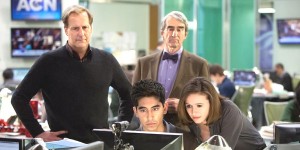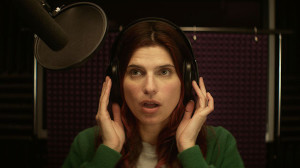Maybe if Jane Fonda had been allowed to channel her third husband when the series started, as opposed to its last couple weeks, more people would say nice things about The Newsroom. As it is, Aaron Sorkin’s unwieldy hybrid of screwball workplace comedy and tag-team poly-sci seminar will wind up its second season this week so distant from the zeitgeist that even people who like the show don’t talk about it much. And when they have lately, it’s to express some degree of disappointment with it, e.g. it’s gotten too slow, too solemn or too much like regular TV, only with more profanity, sex and drugs (and far less of the last two than in Season One). The haters, though yielding a tad more slack to Season Two, say pretty much what they said a year ago – and they keep finding new ways to hate what they see, even though they keep watching anyway.
It’s too bad the crowd has receded. Because after an erratic, even disquieting start, The Newsroom’s second season has brought forth some of the finest work released under Sorkin’s name since The Social Network. And I’m thisclose to declaring this year’s seventh episode, “Red Team III”, better than most of The West Wing during Sorkin’s four-year tenure as executive producer. Directed by Anthony Hemingway (Red Tails, The Wire), “Red Team III” climaxed the season’s running story in which producers, staff and anchors for the mythical Atlantis Cable Network are being deposed by the network’s attorney (Marcia Gay Harden) to prep for what’s been hyped as a potentially devastating lawsuit against ACN; all having to do with an American military operation code-named “Genoa”, which the network reported had deployed chemical weapons against Pakistani civilians. Though second- and third-guessing elements of the report assembled by an ambitious producer (Hamish Linklater), the ACN’s Big Three of anchor Will McAvoy (Jeff Daniels), news director Charlie Skinner (Sam Waterston) and producer Mackenzie McHale (Emily Mortimer) sign off on the story, which nets them their biggest ratings haul in years – and turns out to be completely untrue.
It’s only in this episode that the plaintiff in the lawsuit is disclosed as the report’s justly-fired-and-discredited producer, who claims he’s being scapegoated for what’s labeled “institutional failure.” Apparently, this also encompasses all the mostly embarrassing stuff that’s taken place throughout the year, much of it courtesy of whatever’s meant by “new media”: the on-line nude photos of ACN’s resident brainiac Sloan Stevens (Olivia Munn); the ongoing fallout from the YouTube-d video of a tour bus meltdown by staffer Maggie Jordan (Allison Pill) and other events whose deus ex machina value for Sorkin fit snugly with his show’s not-so-subtle disdain for all things digital, especially the Twitter-verse.
And yes, I know that it’s probably redundant in many minds to place “not-so-subtle” and Aaron Sorkin’s name in the same sentence. In the words of Anthony Lane, Sorkin “raises hectoring to the level of an art.” (One adds with due haste that Lane’s words weren’t applied to Sorkin, but to Jimmy McGovern, a British playwright, who, as with Sorkin, found his greatest notoriety in television while also establishing a reputation in theatrical film.) You have to be in the mood for hectoring and I guess I was in the mood for it last summer when The Newsroom’s first season tore through the TV set like a squall — accompanied, as squalls are, by intervals of humidity. Sorkin’s alternate media history of 2010 was pissed off in general about the same things I was pissed off about during the presidential election summer; which was why, despite the contrary opinions of critics I respect, I bought the whole grandiloquent package. If Sorkin wanted to rant about the decline of civility in public discourse, the cheapening of what used to be considered “news value” and the manner in which presenting facts in a reasonable, even balanced manner could be construed by right-wing fanatics as “slanted,” I was OK with it – up to a point.
That point converged primarily upon women. With the possible exception of Munn’s Sloan (who makes wonky social awkwardness a variable of imperturbable hotness), just about all the principal women characters in The Newsroom’s first season were hyperbolic, dysfunctional, manipulative or some annoying compound of the three. The exceptions were the near-anonymous support staff members with names like Tess (Margaret Watson), Tamara (Wynn Everett) and Kendra (Adina Porter), all of whom seemed composed, competent and fretless. We were kept in the dark about their private lives and I wish the same were true with everybody else in the cast, especially Maggie, her ex-boyfriend Don Keefer (Thomas Sadoski) and her would-be boyfriend Jim Harper (John Gallagher Jr.), who now has a thing for on-line political reporter Hallie Shea (Grace Gummer). Do I like these people? Mostly, I guess. Do I care whether any of them hook up? I do not. I prefer they all put their heads down and get to work the way Tess, Tamara and the others do. And while I understand Will and Mac’s relationship to be the series’ linchpin, I’m so indifferent to their will-they-or-wont-they-reconcile-after-their-bitter-breakup subplot that I’d now rather they never ever get back together…which for all I know may well be how this second season pans out.
What did pan out for certain this season – eventually – is that people on the show were concentrating much more on their work. Operation Genoa may have ruined ACN’s credibility. But it released The Newsroom from its frantic obligation to reboot recent history; just as well, too, judging from the peculiarly ambivalent way the show approached the Occupy Wall Street movement earlier this season. In the process, the women were generally smarter and stronger than last season. Harden’s droll, satiny portrayal of the company attorney provided one of Season Two’s recurring pleasures. Gummer’s character confuses me a little, but I thought her poker-faced autonomy was exactly what Jim had coming to him. I also wanted more of Constance Zimmer’s spiky communications director for the Romney campaign, thinking that if Sorkin insists on finding romance for McAvoy (a.k.a. Hamlet the News Lug), she’d be what government jargon would insist on labeling a “viable option.”
But the most gratifying change from last year has come from Mortimer. Her Mac McHale blossomed this season from a welter of mannerisms and nervous tics into a woman who, when she slows her roll long enough to stare at, or down, a situation, lets you see the rueful wisdom earned with her wounds. Sorkin’s scripts still make her steer cars into curbside garbage containers and induce gibbering noises from her whenever she thinks about the used-to-be that was Will-and-her. But even before she sussed out the fatal flaw in the Genoa story, Mac was showing more self-possession under stress.
I think both she and the show reached a turning point in this season’s fifth episode when she scolds a gay Rutgers student about to come out to his parents on the air during a segment of Will’s show about the Tyler Clementi suicide. One senses that it’s Sorkin’s voice one hears when she’s chiding the student for “bathing in the reflected tragedy” of someone who killed himself because his privacy was violated.
(Sorkin did a lot of this mouthpiece stuff throughout the first season and for much of this one. I admit it. It got old for me, too.)
“I just wanted a way of coming out to my parents without being in the same room,” the student then tells Mac.
“Well, good luck with that,” she says, then, trying to reassure him. “It gets better.”
“How would you know?” he replies.
“I guess I wouldn’t,” she concedes.
Which says to me that, at last, The Newsroom is thinking through things before, and maybe even instead of, emptying its rounds. I wish cable news and new media in general would follow this example.
And if The Newsroom continues to deepen its inquiry into the post-Millennial news business, I hope it hits harder than it has so far upon the whole notion of a 24-hour news cycle, which to my mind has done far greater damage to journalism than Twitter feeds. Whatever happens, the show still likely wont get more traction and attention than the last few episodes of Breaking Bad. I get it. I really do. There hasn’t been a single feature film I’ve seen this year that compares with what I’ve seen so far of Breaking Bad’s last mile. But somehow, it’s become so relatively unfashionable to like The Newsroom that I can see it becoming relatively fashionable again. Just as long as everybody on the show keeps their minds more focused on the news beyond their room.


